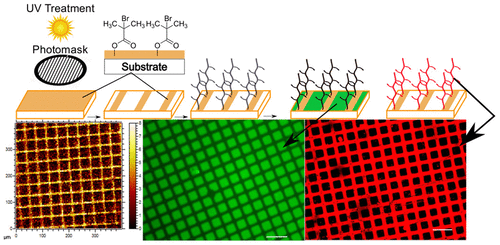Substrate-Independent Micropatterning of Polymer Brushes Based on Photolytic Deactivation of Chemical Vapor Deposition Based Surface-Initiated Atom-Transfer Radical Polymerization Initiator Films.
Published in ACS Applied Materials & Interfaces, 2018
Recommended citation: Kumar, R. & Lahann,J. (2018) ACS Applied Materials & Interfaces, 10, 38, 31965-31976.

Precise microscale arrangement of biomolecules and cells is essential for tissue engineering, microarray development, diagnostic sensors, and fundamental research in the biosciences. Biofunctional polymer brushes have attracted broad interest in these applications. However, patterning approaches to creating microstructured biointerfaces based on polymer brushes often involve tedious, expensive, and complicated procedures that are specifically designed for model substrates. We report a substrate-independent, facile, and scalable technique with which to prepare micropatterned biofunctional brushes with the ability to generate binary chemical patterns. Employing chemical vapor deposition (CVD) polymerization, a functionalized polymer coating decorated with 2-bromoisobutyryl groups that act as atom-transfer radical polymerization (ATRP) initiators was prepared and subsequently modified using UV light. The exposure of 2-bromoisobutyryl groups to UV light with wavelengths between 187 and 254 nm resulted in selective debromination, effectively eliminating the initiation of ATRP. In addition, when coatings incorporating both 2-bromoisobutyryl and primary amine groups were irradiated with UV light, the amines retained their functionality after UV treatment and could be conjugated to activated esters, facilitating binary chemical patterns. Because this novel technique is independent of the original substrate’s physicochemical properties, it can be extended to technologically relevant substrates such as polystyrene, polydimethylsiloxane, polyvinyl chloride, and steel. With further work, the photolytic deactivation of CVD-based initiator coatings promises to advance the utility of patterned biofunctional polymer brushes across a spectrum of biomedical applications. Download paper here